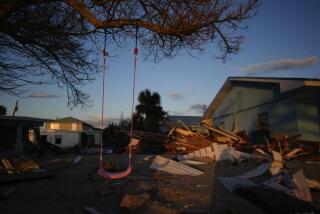Floridaâs Plague: Sick Building Syndrome : Months after opening, one courthouse had moldy walls and workers complaining of nausea and headaches. The problem is widespread in the humid state--and the cure can be costly.
STUART, Fla. â It cost almost $11 million to build and when it was finished, the Martin County Courthouse complex was the pride of this tidy, well-to-do town.
With a shady central courtyard connecting twin three-story buildings, the structure was seen as an architectural delight. And it was functional, too, bringing judicial and administrative offices together in the middle of downtown.
âPeople came out, bands played and there were a lot of warm feelings,â recalled county commissioner Jeff Krauskopf.
But those feelings did not last. Within months of the buildingâs opening in January, 1989, many of the 200 people who worked in the climate-controlled offices began to complain. The place not only smelled bad, but mold began to grow on the walls and on the judgesâ lawbooks.
Soon, more than a few people got sick, complaining of headaches, nausea, skin rashes, even vomiting. Some were admitted to hospitals. Finally, more than 300 people last September marched into a county commission meeting and demanded action.
They got it.
In December, less than four years after it was dedicated with civic fanfare, the courthouse complex was closed as a health hazard. Now the pride of Martin County stands as a forlorn monument to a nationwide plague that has taken hold with special virulence in hot, humid Florida: sick building syndrome.
âWeâve got some real problems here,â said David Peach, a construction boss hired to oversee a rehabilitation project expected to take a year and cost at least $3.5 million. âThere is mold growing on the walls, the air conditioning system is contaminated with fungi, and we think there are leaks in the roof. Even some of the furniture is moldy.â
The cure is drastic. Beginning this month, the courthouse will be all but gutted as workers wearing respirators and body suits rip out the entire air conditioning system, the drywall, insulation, carpet, ceiling tile and acres of vinyl wall covering, Peach said.
Roger C. Inman, director of toxicology and hazard assessment for the stateâs Department of Health and Rehabilitative Services, said that the Martin County Courthouse is typical of office buildings poorly designed for Florida, where moisture is abundant and legions of fungi and molds flourish. Complaints about toxic indoor air, he said, pour into his Tallahassee office at the rate of 25 a day and are increasing.
âThe problem is just tremendous,â Inman said, âand itâs being made worse by buildings constructed to northern standards where the only source of fresh air is the air conditioning system and the AC systems arenât able to handle the amount of moisture being pulled from the air.â
In sealed buildings, excess water from the air conditioner or from the frequent seasonal rains can collect behind walls and foster mildew and mold. Some of these microbial plants are suspected cancer agents.
Martin County, just north of Palm Beach in central Florida, has spent $1.7 million so far on environmental studies, attorney fees, rental of temporary quarters and moving expenses. Some county workers are housed in trailers parked behind the courthouse.
As bad as the problems here are, they are not the worst in Florida. West of Orlando, Polk Countyâs five-year-old courthouse, also declared sick, has been evacuated and the cost of making that building well has been estimated at $20 million. Ten stories tall and finished with imported marble tile, the Polk County courthouse cost $37 million to build.
In addition to biological pollutants, the air in sealed buildings can contain a host of chemical pollutants, including pesticides, formaldehyde and toners used in copying machines. According to Leroy Miles, Floridaâs only environmental inspector assigned to investigate sick buildings. Private homes in which the windows are kept shut for security reasons also can be hazardous to health.
In Martin County, legal claims are piling up. The county has sued the courthouse builder, engineers and architects. At least 21 employees have filed claims against the county.
âPeople are upset,â said Assistant County Administrator Peter Cheney. âThese things shouldnât happen. It gives the people the unfortunate impression that government doesnât do things right.â
Toxicologist Inman said the National Science Foundation estimates that as many as 15% of all Americans are affected by toxic indoor air and that the percentage in Florida is even higher.
âPeople get so excited about their drinking water and we only drink two liters a day,â he said. âYet we breathe 20,000 liters of air a day and these poisons are directly absorbed by the lungs. Itâs a big problem.â
For years, Inman has been asking the Florida Legislature for $850,000 to set up a statewide monitoring program and hire eight inspectors. So far the state has not acted.
âPeople in Florida tend to have a high incidence of sinusitis and allergies because of the naturally high levels of molds and allergens in the air,â said Inman. âWith (sick building syndrome), we canât even define the scope of the problem. We just put out fires and try to help where we can. But thatâs not providing citizens with the help we should be giving.â
More to Read
Sign up for Essential California
The most important California stories and recommendations in your inbox every morning.
You may occasionally receive promotional content from the Los Angeles Times.










